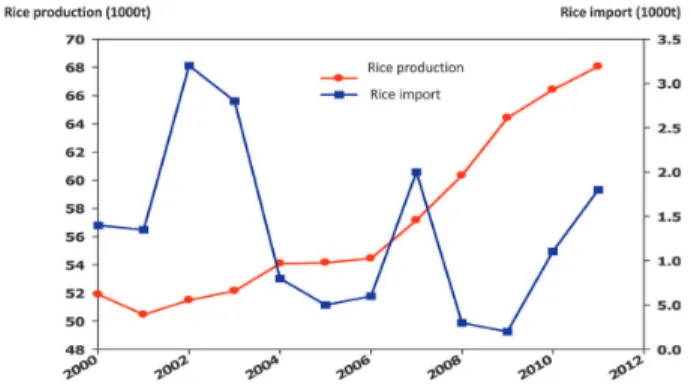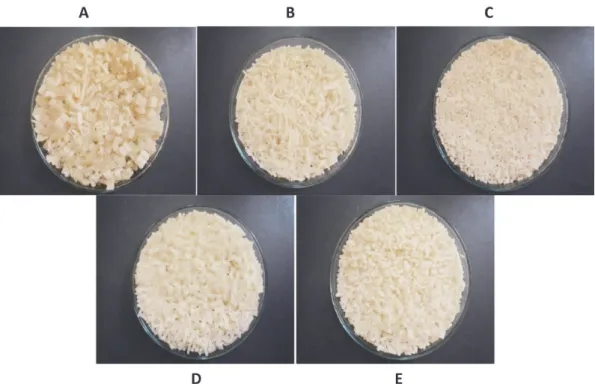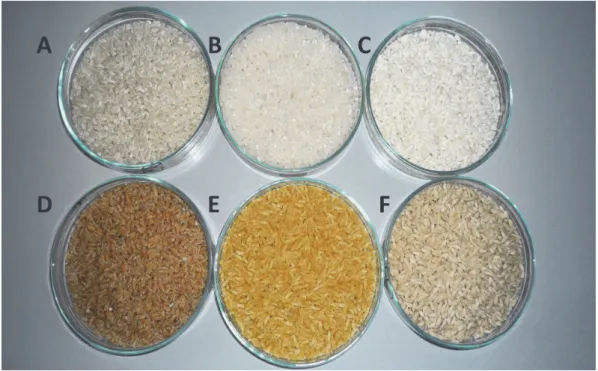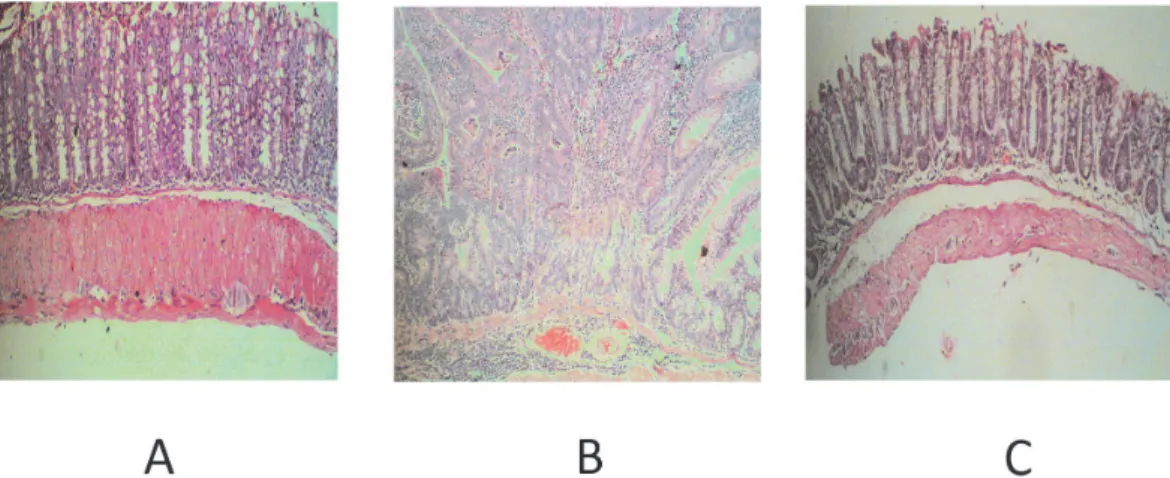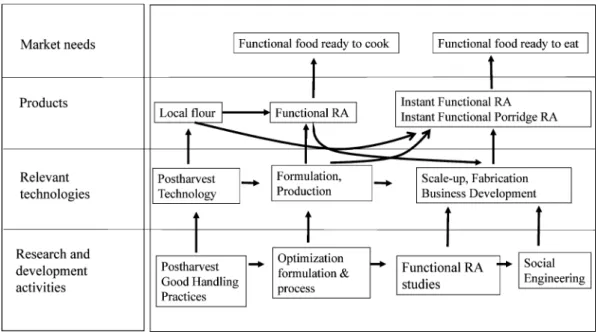D
evel opm
ent of Ri c e Anal og as a Food
D
i ver s i f i c at i on Vehi c l e i n I ndones i a
著者
BU
D
I J AN
TO
Sl am
et , YU
LI AN
A N
anc y D
ew
i
j our nal or
publ i c at i on t i t l e
J our nal of D
evel opm
ent s i n Sus t ai nabl e
Agr i c ul t ur e
vol um
e
10
num
ber
1
page r ange
7- 14
year
2015- 08- 28
U
RL
ht t p: / / hdl . handl e. net / 2241/ 00150247
Development of Rice Analog as a Food Diversification
Vehicle in Indonesia
Slamet Budijanto
1, 2* and Nancy Dewi Yuliana
1, 21
Department of Food Science and Technology, Faculty of Agricultural Engineering and Technology, Bogor Agricultural University, IPB Darmaga Campus, PO BOX 220, Bogor 16680, Indonesia
2Southeast Asian Food and Agricultural Science and Technology (SEAFAST) Center, Jl. Puspa 1,
Bogor Agricultural University, IPB Darmaga Campus, Bogor 16680, Indonesia
Indonesia’s high dependency on rice makes the country prone to food insecurity. To improve food security, the government of Indonesia started a food diversification program in 1974. However, no significant results have yet been achieved, and rice consumption is still high. Apossible explanation is that there is still no suitable “vehicle” in which to deliver diverse local carbohydrate sources in an acceptable form that mimics rice. An appropriate vehicle should be widely acceptable, not require changes to local dietary habits or cooking techniques, fit into Indonesian cuisine, and be makeable from a wide range of sources. “Rice analog” (RA) meets the criteria and could be developed as a food diversification vehicle. It offers a novel way of turning diverse local carbohydrate sources into a new staple food, but comprehensive research is required for its successful development. Upstream activities include crop development and cultivation. Downstream activities include process optimization, machinery design, and developing RAwith specific functional properties, such as low glycemic index, high fiber content with hypocholesterolemic activity, and chemo-preventive activity. These functional properties can be used to promote RA. We hope to switch Indonesian perceptions so that paddy rice is not seen as the only staple food, and so that consuming non-rice staples will not lower social status. The establishment of a new paradigm will encourage people to consume more diverse carbohydrate sources, not only in the form of RA, but also as other foods.
Key words: carbohydrate, extrusion, food diversification, food security, rice analog
───────────────────────
Introduction
Many crops that supply carbohydrates grow well in Indonesia, including cereals (rice, maize, sorghum, foxtail millet), tubers (cassava, sweet potato, potato, arrowroot, canna), and tree crops (sago, breadfruit, banana). The variety of staple foods consumed by Indonesians before 1960 was diverse; the four main staple crops were rice (53.5% of diet), cassava (22.2% of diet), maize (18.9% of diet), and potatoes (4.99% of diet) (Suhardjo, 1998; Suyono, 2002). However, as the standard of living of Indonesians has improved, the consumption of rice, which is associated with high
social status, has increased faster than that of other staple foods. In 2012, Indonesian rice consumption was about 130 kg/person/year, higher than the average world level of 60 kg/person/year (Budijanto, 2014). To meet demand, Indonesia must import rice. Rice remains popular because its physical form is the most suited to Indonesian food culture, in which staple foods are eaten along with side dishes.
However, Indonesia’s high dependency on rice makes the country prone to food insecurity. To im-prove food security, the government of Indonesia started a food diversification program in 1974. Wheat flour was introduced at affordable prices, and
wheat-Received: September 16, 2014, Accepted: January 20, 2015
* Corresponding author: Department of Food Science and Technology, Faculty of Agricultural Engineering and Technology, Bogor Agricultural University, IPB Darmaga Campus, PO box 220, Bogor 16680, Indonesia.
based products such as noodles, cakes, and bread became popular. By 2011, wheat flour consumption had reached 5.4 Mt and in 2012, wheat imports reached 6.2 Mt (USDA, 2013). But over the same period, the consumption of local non-rice, non-wheat staple foods has faded. The success of wheat is an irony, since the Indonesian climate is not suited to growing wheat, yet so many local crops that grow well are neglected.
However, besides wheat, the program has not yet shown any encouraging results, and rice consumption is still high. Apossible explanation is that there is no suitable “vehicle” in which to deliver diverse local carbohydrate sources in a culturally acceptable form. We propose a “rice analog” (RA) that is made from non-rice carbohydrates. Improving its functional pro-perties may help to improve consumer acceptance and nutrition in Indonesia.
Efforts to reduce high dependence on rice
In the first decade of this century, rice production in Indonesia continued to increase, reaching 66 Mt in 2010 (Fig. 1). However, except in 2008, production did not meet demand, and rice had to be imported.
This high dependency on rice makes Indonesia prone to food insecurity, especially when consumption continues to increase faster than production, thereby increasing prices. Rice price increments were the biggest contributor (1.3% of 7.0% inflation rate) to inflation in Indonesia in 2010 (Ministry of Indonesian Secretariat, 2010). Government decisions to import rice are required to secure stocks and to stabilize prices, but climate variability influences the avail-ability of world rice stocks as well. One solution is to develop non-rice products which can be easily ac-cepted by the majority of Indonesian people and can be
made from local materials.
1. Food diversification program
Although the food diversification program was initiated in 1974, expectations have not yet been met. Various options are available (Budijanto, 2014): (1) Increasing public knowledge about the benefits of consuming more diverse food. (2) Providing more diverse carbohydrate-based products which are easy to prepare and consume. (3) Encouraging the private sector to develop a food industry based on local carbohydrates. (4) Encouraging small to medium enterprises and food businesses to develop products or menus based on local carbohydrates. (5) Stimulating the exploration of local carbohydrate sources. (6) Providing incentives for businesses and communities to develop such a food industry.
2. Lesson learnt from wheat-based food diver-sification
The most successful diversification effort so far has been the introduction of wheat flour. However, this success has created a high dependence on imports. Besides strong support from the government, the success of the introduction is due to the many bene-ficial properties of wheat flour which other flours lack. The development of an alternative needs serious, consistent effort to seek a vehicle for rice, non-wheat carbohydrate sources. One option is to develop RAand noodles from various local carbohydrate sources, because rice and noodles are the most ac-ceptable forms of carbohydrate to most Indonesians.
New option for a carbohydrate vehicle
Many sources of carbohydrates are grown in Indonesia, such as arrowroot, canna, cassava, and sweet potato. Breadfruit is common, especially in Java. Sago is the staple in Maluku and Papua, and maize is eaten in East Java, Madura, and South Sulawesi. Attempts to use local food sources should become an integral part of efforts to strengthen na-tional food security through self-sufficiency and food sovereignty. The food diversification program needs a vehicle which must be widely acceptable, not require changes to local dietary habits or cooking techniques, fit into Indonesian cuisine, and be made from local sources.
RAand noodles meet these criteria. We focus here on RA. RA can be made from almost any flour into a rice-grain-like shape and is cooked similarly. It can also be processed to suit a variety of Indonesian
cui-J. Dev. Sus. Agr. 10 (1) 8
sines. This latter characteristic is important in the integration of RAinto Indonesian society because it does not require a change to eating habits.
1. RA processing technology
In the 1960s, the Indonesian government introduced
tekad rice, a grain-shaped product made from a mix-ture of rice, cassava, maize, and soybeans by cold extrusion. Unfortunately, it was not successful, be-cause it didn’ t look like rice, it had poor cooking quality, and it was misconceived as an attempt to displace rice. This experience showed that to develop a suitable vehicle, attention should be given not only to technological feasibility, but also to social feasibility. Our lab developed RAby using hot extrusion technology (Budijantoet al., 2012a, b). By optimizing critical parameters such as the water content of the dough, process temperature, feeding rate, screw rotational speed, and blade rotation speed, we can manufacture RAwith the desired grain shape (Fig. 2). Unlike cold extrusion and granulation techniques, hot extrusion can produce RAwith a shape and cooking quality very similar to those of rice (Table 1). It allows the use of various raw materials, and is feasible for use in medium- to large-scale manufac-turing.
2. Exploration of raw materials to produce rice analog
Our group has successfully developed RAfrom various carbohydrate sources, including maize, sor-ghum, rice, and sago (Fig. 3). The products resemble the original in shape, but the color still needs to be improved (Budijantoet al., 2012a, b), while the use of cassava, sago, and coconut pulp resulted in glutinous rice-like AR (Fig. 3C). The raw materials and degree of gelatinization also affect sensory acceptance: RA made from sorghum cultivars Pahat and Numbu had better sensory acceptance than RAmade from B100 and Genjah. The difference is due to the different colors and concentrations of amylose + amylopectin and tannins of the different sorghums. The amylose and amylopectin content influences the stickiness of the RA, but high levels of tannins cause a bitter taste. The incorporation of other raw materials such as purple and yellow sweet potato and yellow maize results in RAwith an attractive color (Fig. 3D-F).
3. Functions of rice analog
Hot extrusion technology allows flexibility in the selection of raw materials to give the desired sensory properties (Muaris and Budijanto, 2013). RAcan thus be manufactured as a functional food and for nutrient
fortification.
RA as a functional food
Our group is currently focused on the development of functional RAs with a low glycemic index (GI) and antioxidant, hypocholesterolemic, anti-proliferative effects against cancer cells, and chemo-preventive activities. We are also identifying the stages in the process of RAmanufacture that affect its functional properties.
Foods are considered low GI (<55), medium GI
(55-70), or high GI (>70) (Miller et al., 1995).
Many carbohydrate crops in Indonesia have a low GI. RAformulated from maize, soybeans, and rice bran had a GI of 54±18 and a vitamin C equivalent
antioxidant capacity of 7. 51μg/mg (our unpublished results).
Afood can be regarded as a source of fiber if it contains≥3 g dietary fiber per 100-g serving, and as a high-fiber food if it contains ≥6 g per 100-g serving (Codex, 1997). Dietary fiber has been shown to lower the risk of cardiovascular disease, diabetes, hyperten-sion, hypercholesterolemia, and other degenerative
J. Dev. Sus. Agr. 10 (1) 10
Cold extrusion Parameter
Industrial scale
Table 1. Comparison ofthree technologies for producing rice analog.
Micro to small scale Small to medium scale
Medium to large scale Production capacity
Technology
Difficult to make Not similar to rice
Round
Less diverse Very diverse
Raw materials
Granulation
Small to medium scale Cooking quality
Not similar to rice Similar to rice
Shape and color of fortified product
Less diverse Micro to small scale Pellet shape
Similar to rice Product shape
Not similar to rice Similar to rice
Hot extrusion
Medium to large scale
diseases (Andersonet al., 2009). Our low-GI RAhad a fiber content of 13.3% (unpublished results). Other formulations using sorghum, maize, and soybean achieved a fiber content of 5.84% and a GI of 50±25
(Noviasari et al., 2013).
Anti-proliferative effects of sorghum methanolic extract as a main RAingredient against human colon cancer cells (HCT 116) remained stable or even increased during the AR production process (our unpublished results). Anin vivostudy of the chemo-preventive properties of RAenriched with red palm oil in azoxymethane and dextran sodium sulphate-induced BALB/c mice is currently in progress. The colon histopathology of such mice that had been fed RAwas no different from that of normal healthy mice fed a standard diet (Fig. 4; unpublished results). However, further research on the chemo-preventive mechanism is still needed.
Sweet potato (Ipomoea batatas) has a rich content of dietary fiber, carotenoids, and anthocyanins. The gut microflora of mice fed dietary fiber extracted from sweet potato was much healthier than that of control mice (Takamineet al., 2005). Sweet potato is a source of carotenoids (provitamin A). The consumption of orange sweet potato improved the vitamin Astatus of children and women in Uganda and Mozambique (Hotzet al., 2012a, b). Purple sweet potato is rich in anthocyanins. Zhang et al. (2009) reported the hepa-toprotective activity of purple sweet potato in vitro, and Konczak-Islam et al. (2003) concluded that an aqueous extract rich in these anthocyanins had
chemo-preventive properties.
We have created RAusing yellow and purple sweet potato. The results of sensory tests were good (Budijanto et al., 2013). Research on functional pro-perties will be conducted in the near future.
Other innovations to create RAwith functional properties involve the use of herbs, spices and vegetables, which in addition to being condiments have many health benefits. Our current formulation uses ingredients which are reported to control blood sugar levels, such as bay leaf, lemon grass, onion, garlic, and ginger.
RA as a fortification vehicle
RAis an excellent vehicle for fortification, parti-cularly with iron. Its inherent familiarity will allow fortification programs to reach large populations. It can also be used as vehicle for other nutrients such as vitamin A, Zn, folic acid, and thiamin. In addition to redressing deficiencies, these components can also reduce the risk of diseases such as cardiovascular disease, diabetes, and cancer, and reduce oxidative stress (Benito et al., 1991; Evans et al., 2001; Mc-Caddon et al., 2002; Opara, 2002; Ho et al., 2003). With the potential to include a wide variety of nutrients, RAcan give double benefits, both improving the nutritional status of Indonesians and reducing the risk of lifestyle diseases which are starting to emerge in Indonesia.
Further R&D on RA as vehicle for food diversification
Following R&D to optimize the production and formulation of RAwith good sensory acceptance, laboratory-scale and pilot-plant-scale work has focused on the development of ready-to-eat products such as instant RAor instant porridge. We drew up a “roadmap” for the development of RAas vehicle for food diversification (Fig. 5).
The roadmap intends that successful RAcommer-cialization will stimulate farmers to grow local crops as raw materials for RAmanufacture. This will stimulate the growth of flour and starch processing industries, which will ultimately increase the value of the com-modities. Many research areas are possible but will be difficult to implement: a lack of cooperation among stakeholders is the main reason. Asuccessful RA industry can be achieved by implementing the “academic, business, government, and community” model (Bangun et al., 2012; Budijanto, 2014). Syn-ergistic cooperation between these stakeholders will be required for the successful implementation of research results in the food industry. The stakeholders should take the following roles:
1. Higher education: conducting research on RApro-cessing technology and functional properties (on-farm-off-farm integration).
2. Industry: designing and engineering RAmachinery (e. g., extruders); developing local commercial flour and RAindustries.
3. Government: promotion of the importance of eat-ing a more diverse diet.
4. Farmers: growing crops for raw materials in ac-cordance with good agricultural practice.
We hope that this integrated approach will allow local carbohydrate resources to form a strong foundation for national food security in Indonesia.
Conclusion
The exploration of alternatives to food production to reduce Indonesia’s dependence on rice and wheat is a strategic step toward ensuring food self-reliance through food diversification. We see RAproduction technology as a breakthrough in producing a food diversification vehicle that can be widely accepted by the public. By using raw materials from diverse local sources and with its potential for mass production, RA can deliver a variety of carbohydrates to Indonesians’ dining tables. Comprehensive research involving experts from various disciplines and stakeholders is required to support successful development. This will require upstream to downstream research and con-sumer testing. Upstream activities will include crop development and cultivation. Downstream activities will include the optimization of production,
engi-J. Dev. Sus. Agr. 10 (1) 12
neering and design of equipment, and testing of RA functional properties. Ideally, successful RAdevel-opment will convince society that rice is not the only staple food, and change the perception of the public, including the media, that consumption of non-rice carbohydrates reflects social status. The public can become accustomed to eating various sources of carbohydrates, both RAand other foods, with en-joyment, which will imforce Indonesian food diver-sification programme, and finally strengthen Indo-nesian food security.
Acknowledgements
The authors gratefully acknowledge the Ministry of Research and Technology, West Java Provincial Government, for National Strategic Research Grant 2012-2013, and Bogor Agricultural University for
University Strategic Research Grant 2012-2013.
References
Anderson, J.W., Baird, P., Davis, R.H. Jr., Ferreri, S., Knudtson, M., Koraym, A., Waters, V., Williams, C.L. 2009. Health benefits of dietary fiber.Nutr. Rev. 67, 188-205. Benito, E., Stiggelbout, A., Bosch, F.X., Obrador, A., Kaldor, J.,
Mulet, M., Muñoz, N. 1991. Nutritional factors in colorectal cancer risk: a case-control study in Majorca.Int. J. Cancer49, 161-167.
Badan Pusat Statistik (BPS). 2011. Survei Sosial Ekonomi Nasional, Jakarta. (Statistics Indonesia. National Eco-nomic Survey. In Bahasa)
Badan Pusat Statistik (BPS). 2012. Survei Sosial Ekonomi Nasional, Jakarta. (Statistics Indonesia. National Eco-nomic Survey. In Bahasa)
Bangun, Y. R., Sukarya, F. R. 2012. Calling for ABG (Academic-Business-Government) leadership early iden-tification of effective characteristics of leadership to support triple helix model.Procedia Soc. Behav. Sci.52, 187-196.
Budijanto, S. 2014. Beras analog sebagai vehicle pengan-ekaragaman pangan untuk memperkokoh keanpengan-ekaragaman pangan.IPB Press. Bogor. (Rice analog as a vehicle food diversification program to enforce food security. In Bahasa)
Budijanto, S., Yulianti. 2012a. Studi persiapan tepung sorgum (Sorghum bicolor l. Moench) dan aplikasinya pada pembuatan beras analog.J. Teknol. Pert.13(3), 177-186. (Study on sorghum flour preparation and its application in rice analogue production. In Bahasa)
Budijanto, S., Sitanggang, A.B. 2011. Produktivitas dan proses penggilingan padi terkait dengan pengendalian faktor mutu berasnya. Majalah Pangan. 20, 1-12. (Production and process of paddy milling in relation with rice quality. In Bahasa)
Budijanto, S., Faridah, D., Yuliana, N. D. 2013. Metode pengolahan beras analog rendah indeks glisemik.
Kementrian Hukum dan HAM. P00201304641. (Method of low GI rice analog processing. In Bahasa)
Budijanto, S., Sitanggang, A.B., Purnomo, E.H. 2012b. Metode Pengolahan Beras Analog. Kementrian Hukum dan HAM. P00201200. (Method of rice analog processing. In Bahasa).
Codex Alimentarius Commission. 2009. Guidelines for use of nutrition and health claims. Nutrition and Health Claims. http: //www. codexalimentarius. net/input/download/ standards/351/CXG_023e. pdf. [accessed on 18th January 2015)
Evans, P., Halliwell, B. 2001. Micronutrients: oxidant/anti-oxidant status.Br. J. Nutr.85, S67-S74.
Government of United States. USDAForeign Agricultural Services. 2013. Global Agricultural Information Network Report. Indonesia grain and feed annual Indonesia grain and feed annual report 2013 http: //gain. fas. usda. gov/ Recent GAIN Publications/Grain and Feed Annual_ Jakarta_Indonesia_4-11-2013. pdf. [accessed on 24th March 2014].
Ho, P.I., Ashline, D., Dhitavat, S., Ortiz, D., Collins, S.C., Shea, T. B., Rogers, E. 2003. Folate deprivation induces neurodegeneration: roles of oxidative stress and increased homocysteine.Neurobiol Dis.14 (1): 32-42.
Hotz, C., Loechl, C., de Brauw, A., Eozenou, P., Gilligan, D., Moursi, M., Meenakshi, J. V., 2012a. Alarge-scale intervention to introduce orange sweet potato in rural Mozambique increases vitamin Aintakes among children and women.Br. J. Nutr.108, 163-176.
Hotz, C., Loechl, C., Lubowa, A., Turnwine, J.K., Ndeezi, G., Masawi, A.N., Baingana, R., Carriquiry, A., de Brauw, A., Meenakshi, J.V., Gilligan, D.O. 2012b. Introduction ofβ -carotene-rich orange sweet potato in rural Uganda resulted in increased vitamin Aintakes among children and women and improved vitamin Astatus among children. J. Nutr. 142, 1871-1880.
Konczak-Islam, I., Yoshimoto, M., Hou, D. X., Terahara, N., Yamakawa, O. 2003. Potential chemopreventive properties of anthocyanin-rich aqueous extracts from in vitro produced tissue of sweetpotato (Ipomoea batatas L.). J. Agric. Food Chem.51, 5916-5922.
Inflation and rice price. Indonesian Ministry of Secretariat. 2010. http: //www. setneg. go. id/index. php? option=com_ content&task=view&id=5171. [accessed on 17th
January 2015]
McCaddon, A., Regland, B., Hudson, P., Davies, G. 2002. Functional vitamin B12 deficiency and Alzheimer disease. Neurology58, 1395-1399.
Miller, B. J., Foster-Powell, K. 1995. International tables of glycemic index.Am. J. Clin. Nutr.62, 871-890.
Muaris, H, Budijanto, S. 2013. Beras Analog. Gramedia. Jakarta. (Rice Analogue. In Bahasa)
Noviasari, S., Kusnandar, F., Budijanto, S. 2013. Pengem-bangan beras analog dengan berbasis pemanfaatan jagung putih 24 (2), 161-167.J. Teknol. Industri Pangan. (De-velopment of rice analogue from white corn. In Bahasa) Opara, E. C. 2002. Oxidative stress, micronutrients, diabetes
Suhardjo. 1998.Konsep dan Kebijakan Diversifikasi Konsumsi Pangan dalam Rangka Ketahanan Pangan. Prosiding Widyakarya Nasional Pangan dan Gizi VI. LIPI Jakarta. (Concept and policy of food diversification to support food security. In Bahasa)
Suyono. 2002. Peta Pangan dan program Penganekaragaman Pangan 1939-2002 (63 Tahun) Dalam Penganekaragaman Pangan. Prakarsa Swasta dan Pemerintah Daerah.Forum Kerja Penganekaragaman Pangan. 2003. Jakarta. (Food roadmap and food diversification program 1939-2002 (63
years). In Bahasa)
Takamine, K., Hotta, H., Degawa, Y., Morimura, S., Kida, K. 2005. Effects of dietary fiber prepared from sweet potato pulp on cecal fermentation products and microflora in rats. J. Appl. Glycosci.52, 1-5.
Zhang, Z.F., Fan, S.H., Zheng, Y.L., Lu, J., Wu, D.M., Shan, Q., Hu, B. 2009. Purple sweet potato color attenuates oxi-dative stress and inflammatory response induced by D-galactose in mouse liver. Food Chem. Toxicol.47, 496 -501.
